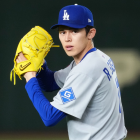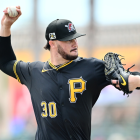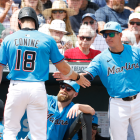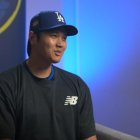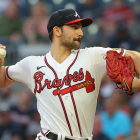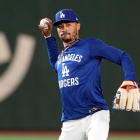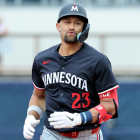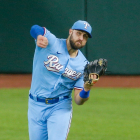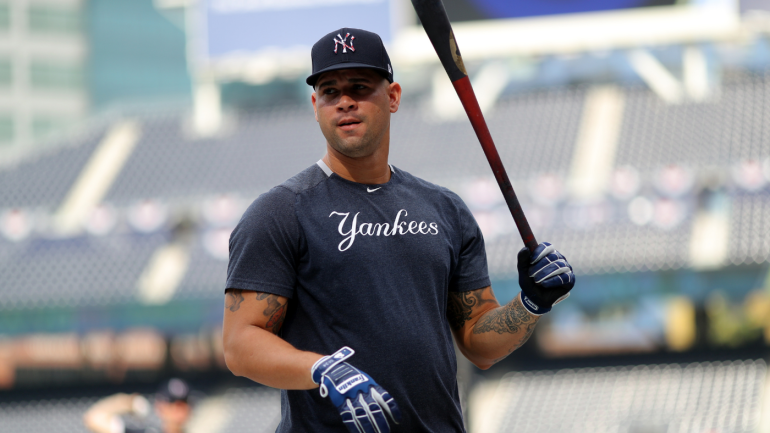
This Wednesday (Dec. 2) is an important date on the offseason calendar. It is the deadline for teams to tender their pre-arbitration and arbitration-eligible players a contract offer for next season. They don't have to sign their players before the deadline, but they do have to make an offer. Players who do not receive a contract offer are considered "non-tendered" and become free agents.
Every year a new batch of players join the free agent pool on the non-tender deadline. Teams typically non-tender players whose salary through arbitration outpaces their production, or players who are expected to miss significant time with injury. Last offseason's non-tenders included Kevin Gausman, Cesar Hernandez, Blake Treinen, and Taijuan Walker.
As teams have become more obsessed with ruthless efficiency in recent years, the number of non-tenders have climbed. Here's the number of players who were non-tendered each of the last five offseasons:
- 2015: 36
- 2016: 35
- 2017: 25
- 2018: 41
- 2019: 53
The expectation within baseball is a record number of players will be non-tendered this offseason as teams get their 2021 payrolls in order amid the COVID-19 pandemic. There are only so many ways to get money off the books in this game. Non-tendering players is the easiest way to do it. Non-tenders clear salary without the need to work out a trade or buyout.
Free agency has been slow-moving to date -- only six of our top 60 free agents have signed -- and I think the expected wave of non-tenders is at least partly to blame for that. Teams don't want to rush into any free agent deals without first seeing who gets non-tendered because better (and cheaper) players may soon be available. Free agency could pick up after Wednesday.
With non-tender day approaching, here is a look at the biggest decision each team is facing prior to the deadline. Some teams have it easy this year. Others are facing potential franchise-altering decisions. All 2021 salary projections come from MLB Trade Rumors.
Biggest non-tender decision: C Carson Kelly ($1.3 million projected salary) The Diamondbacks do not have any serious non-tender candidates now that Junior Guerra has been released, so Kelly gets the nod by default. He followed up his breakout 2019 season with a down 2020, though I doubt the team will cut bait over that. A 26-year-old catcher with four years of control and one comfortably above-average big-league season under his belt is incredibly valuable. Caleb Smith and Luke Weaver are Arizona's only other arbitration-eligible players. They don't have a big decision coming. Those two and Kelly will be tendered contracts and remain with the team. Other non-tender candidates: None | |
Biggest non-tender decision: IF Johan Camargo ($1.9 million projected salary) Adam Duvall's huge 2020 season took him off the non-tender chopping block and solidified his spot with the 2021 Braves. Camargo has been hurt and ineffective since his 2018 breakout, with his swing-and-miss issues particularly surprising. Atlanta has Austin Riley at third and they've been connected to some bigger-name third basemen in recent weeks (i.e. Kris Bryant), so they do not seem likely to give Camargo another go next year. A soon-to-be 27-year-old switch-hitter who can play all over the infield (and some outfield) is a useful piece for a contender, just not at nearly $2 million. Other non-tender candidates: LHP Grant Dayton, RHP Luke Jackson | |
Biggest non-tender decision: IF Hanser Alberto ($2.6 million projected salary) Elite contact ability and near-league-bottom exit velocity have allowed Alberto to dink and dunk his way to a .317 batting average on balls in play the last two years, though he doesn't do much else other than put the bat on the ball, especially with his glove having gone backward. The Orioles aren't exactly flush with infield depth, though a rebuilding team spending nearly $3 million on a no power, middling defense journeyman isn't a thing that usually happens. With Renato Nunez having already been released (and replaced by waiver claim Chris Shaw), Alberto is Baltimore's biggest non-tender decision. Other non-tender candidates: C Pedro Severino, IF Pat Valaika | |
Biggest non-tender decision: RHP Matt Barnes ($4.1 million projected salary) All you need to know about the current state of the Red Sox is that they've had eight pitchers clear waivers this offseason -- any team could have had them for free and they all passed -- and those eight pitchers threw more than one-quarter of Boston's innings in 2020. Ouch. Ryan Weber was one of those eight pitchers, leaving Barnes, the team's nominal closer, as Boston's only real non-tender decision. His big strikeout rates will get him paid well through arbitration, though his walk and homer issues limit his on-field value. The bet here is the Red Sox keep Barnes. Other non-tender candidates: RHP Austin Brice | |
Biggest non-tender decision: 3B Kris Bryant ($18.6 million projected salary) Wouldn't it be something if the Cubs non-tendered Bryant after all the service time shenanigans (and the grievance that took nearly five years to resolve)? It's insane Bryant, a 28-year-old former MVP who played at an All-Star level as recently as 2019, is being discussed as a non-tender candidate -- teams that are trying to contend don't even entertain such ideas -- but such is the state of Chicago's finances, or so owner Tom Ricketts claims. Bryant had a miserable 2020 season while playing hurt and, if the Cubs are unable to find a suitable trade prior to Wednesday's deadline, they very well might cut him loose. I think it's far more likely they keep him and hope he rebuilds value next year so they can flip him at the trade deadline (or, gasp, contend), but it is not set in stone. Chicago has several non-tender candidates and Bryant is easily the most notable. Other non-tender candidates: OF Albert Almora Jr., 1B Jose Martinez, OF Kyle Schwarber | |
Biggest non-tender decision: LHP Carlos Rodon ($4.5 million projected salary) The White Sox are likely to non-tender outfielder Nomar Mazara, a former top prospect who's spun his wheels in the big leagues and is projected to make close to $6 million in 2021. Rodon is much more up in the air. Tommy John surgery and shoulder trouble have limited him to fewer than 50 innings the last two years and, when he did pitch, he often showed reduced velocity. The ChiSox are a contender now and there is no such thing as too much pitching depth, so I suspect they will keep Rodon even at his projected salary. The same applies to Reynaldo Lopez. He's projected at nearly $2 million. Other non-tender candidates: Lopez, Mazara | |
Biggest non-tender decision: OF Brian Goodwin ($2.7 million projected salary) The Reds gave up two mid-range prospects to get Goodwin at the trade deadline this summer but I don't think that means his place on the 2021 roster is secure. Depending where Nick Senzel plays, Goodwin might only be their sixth-best outfielder, and teams on a budget usually don't commit nearly $3 million to role players. Squint your eyes and you could see Archie Bradley as a non-tender candidate given a projected salary close to $5 million. Michael Lorenzen's expected move into the rotation all but ensures Bradley will open next year in Cincinnati's bullpen though. Other non-tender candidates: C Curt Casali | |
Biggest non-tender decision: C Austin Hedges ($3 million projected salary) Hedges was part of the Mike Clevinger trade and, truth be told, Cleveland is probably too thin behind the plate to cut him loose. That said, they picked up Roberto Perez's $5.5 million option earlier this offseason, and a small payroll team may not want to commit $8 million or so on two all-glove, no-hit catchers. Remember, money is apparently so tight in Cleveland that they put Brad Hand on waivers in an effort to avoid the $1 million buyout of his club option. It's not often you see a team with a small payroll spend roughly $3 million on a backup catcher. Other non-tender candidates: OF Delino DeShields Jr., OF Tyler Naquin | |
Biggest non-tender decision: RHP Jon Gray ($5.9 million projected salary) Earlier this offseason Rockies ownership sent season ticket holders a letter strongly suggested payroll will come down -- "There will be nothing normal about this offseason as the industry faces a new economic reality," the letter said, according to The Athletic's Nick Groke -- and the easiest way to chop about $6 million off the ledger is non-tendering Gray. The 29-year-old had shoulder problems and was ineffective in 2020, two things that were very likely related, and if the Rockies don't believe he is fixable or are confident in their ability to find a trade partner, they could make a clean break at the non-tender deadline. The guess here is they keep him, though I think it's 50/50 at best. Other non-tender candidates: C Elias Diaz, RHP Jairo Diaz, RHP Chi Chi Gonzalez, C Tony Wolters | |
Biggest non-tender decision: LHP Matthew Boyd ($6.2 million projected salary) The Tigers badly overplayed their hand when dangling Boyd on the trade market -- they wanted Gleyber Torres from the Yankees -- and he's taken an enormous step back since the 2019 trade deadline, so much so that teams may balk at taking on his projected salary even with a thin free agent pitching class. Miguel Cabrera is the only player on Detroit's roster with a guaranteed contract, so the Tigers are not desperate to cut payroll this winter. The bet here is they keep Boyd and hope he rebuilds value next year so they can flip him at the trade deadline. Definitely not a good sign that non-tendering Boyd is not completely insane though. Other non-tender candidates: UTIL Niko Goodrum, RHP Buck Farmer, RHP Michael Fulmer, LHP Daniel Norris | |
Biggest non-tender decision: UTIL Aledmys Diaz ($2.8 million projected salary) The Astros already answered their biggest non-tender question when they outrighted Roberto Osuna a few weeks ago. He's now a free agent and would have banked more than $10 million through arbitration thanks to his 155 career saves. With Osuna gone, Diaz gets the nod by default because Carlos Correa and Lance McCullers Jr. are the only other arbitration-eligible players on the roster. Diaz is a good enough hitter and a good enough defender at multiple positions to be worth a roster spot on a contending team. The only question is whether the Astros want to commit nearly $3 million to such a player. Other non-tender candidates: None | |
Biggest non-tender decision: 3B Maikel Franco ($5 million projected salary) Franco's huge 2015 breakout feels like it was just yesterday, doesn't it? The Royals signed him to a low risk one-year deal last winter and he responded with his best season since that 2015 breakout. As a reward, he may get non-tendered for the second straight winter. That's a hefty salary projection for a player who will qualify for free agency next year and may not have a long-term spot in Kansas City. When you have exit velocity darling Kelvin Gutierrez in the organization at the same position, spending roughly $5 million on Franco isn't the best use of resources. Other non-tender candidates: None | |
Biggest non-tender decision: RHP Hansel Robles ($3.9 million projected salary) Very quietly, the Angels have had strong success on the waiver wire in recent years, including getting 125 2/3 innings of 3.67 ERA ball from Robles since his 2018 claim. He was the team's regular closer in 2019, but diminished velocity led to 20 runs in 16 2/3 innings in 2020, putting him in the non-tender crosshairs. The Angels aren't blessed with great pitching depth, so hanging on to Robles and seeing whether he rebounds with a normal-ish spring training would be justifiable. The guess here is they cut bait entirely and redirect the money toward a pitcher who didn't allow more than a run per inning this summer. Other non-tender candidates: RHP Justin Anderson, RHP Keynan Middleton, RHP Noe Ramirez | |
Biggest non-tender decision: LHP Scott Alexander ($1 million projected salary) Even with a pricey seven-player arbitration class (Cody Bellinger, Walker Buehler, Corey Seager, and Julio Urias are all arbitration-eligible this winter), the Dodgers don't have any obvious non-tender candidates. Alexander has spent the last two years as a solid up-and-down depth arm and his projected salary is a drop in the bucket for Los Angeles, plus Caleb Ferguson's Tommy John surgery creates an opening for another lefty in the bullpen. That said, Victor Gonzalez and Adam Kolarek remain, and the Dodgers have a small army of interesting (and cheap) young arms they could turn to instead. Ultimately, I think Alexander stays. Other non-tender candidates: None | |
Biggest non-tender decision: 1B Jesus Aguilar ($3.9 million projected salary) The Marlins have two prominent non-tender candidates in Aguilar and righty Jose Urena, who is also projected for a $3.9 million salary next year. Miami is fairly deep in arms and Urena hasn't pitched well the last two years, so I think he'll get non-tendered. His situation is more predictable than Aguilar's. The Marlins have an extremely similar player to Aguilar in Garrett Cooper, and top prospect Lewin Diaz is knocking on the door. Spending roughly $4 million on a one-dimensional first baseman who can be replaced from within is not usually something a small-payroll team does. Aguilar's clubhouse leadership and the inevitable approval of the universal DH just may keep him on the roster another year though. Other non-tender candidates: LHP Richard Bleier, RHP Yimi Garcia, RHP Ryne Stanek | |
Biggest non-tender decision: RHP Corey Knebel ($5.125 million projected salary) Few teams have been as aggressive with non-tenders as the Brewers lately -- they non-tendered eight players the last two years -- and they've spent the early part of the winter cutting payroll through option declines. Probably not a good sign for their non-tender candidates. Knebel was as nasty as they come from 2017-18, but Tommy John surgery sidelined him in 2019 and hamstring trouble limited him to 13 1/3 ineffective innings in 2020. Milwaukee already has one reliever making big money through arbitration (Josh Hader), and Knebel at more than $5 million just might not be feasible. No doubt the Brewers will scour the trade market before non-tendering him. Other non-tender candidates: OF Ben Gamel, C Manny Pina, C Omar Narvaez, UTIL Jace Peterson | |
Biggest non-tender decision: OF Eddie Rosario ($9.6 million projected salary) Power pays in arbitration and Rosario's 96 home runs the last four years are the 30th most in baseball. The problem is he doesn't do a whole lot other than hit homers. He's a low on-base hitter, he doesn't contribute much on the bases, and his left field defense is adequate more than an asset. Alex Kirilloff is one of the top prospects in the game and he's MLB-ready -- the Twins think so much of Kirilloff that they let him make his big league debut in Game 2 of the Wild Card Series -- and could easily step in to replace Rosario in left field next year, allowing Minnesota to reallocate that projected salary toward pitching. I think Rosario's a goner. Other non-tender candidates: None | |
Biggest non-tender decision: LHP Steven Matz ($5.1 million projected salary) The Mets have a massive 13-player arbitration class and yet only one of those 13 players is on the non-tender fence. Extra outfielder Guillermo Heredia will be non-tendered -- that's not a decision the Mets will have to debate much -- and Matz's spot is up in the air. Matz allowed 33 runs in 30 innings this past season and surrendered his highest average velocity in years, and those numbers usually equal a non-tender. That said, he made 30 league-average starts in 2018 and again in 2019, so you needn't look back far to see the last time he was an effective pitcher, plus the Mets need rotation depth. New owner Steve Cohen is ready to spend and Matz's projected salary isn't onerous. I think this one's 50/50. It wouldn't surprise me to see the Mets keep Matz or cut him loose. Could go either way. Other non-tender candidates: Heredia | |
Biggest non-tender decision: C Gary Sanchez ($5.5 million projected salary) Sanchez had a "worst player in baseball" kind of season in 2020 and it put his future with the Yankees in doubt. The Yankees are not blessed with much depth behind the plate, however, and it was only a year ago that the soon-to-be 28-year-old Sanchez hit 34 home runs and was an All-Star. I think non-tendering Sanchez is something fans are debating and reporters are speculating about more than the Yankees are seriously considering, though he does stand out as New York's most notable non-tender candidate heading into Wednesday's deadline. Other non-tender candidates: RHP Luis Cessa, RHP Ben Heller, RHP Jonathan Holder | |

Athletics
| |
Biggest non-tender decision: UTIL Chad Pinder ($2.2 million projected salary) It has been three years since Pinder's out-of-nowhere great 2018 season. In the two seasons since, he's posted a sub-.300 on-base percentage with underwhelming defense no matter where he's played, and budget teams like the Athletics can't afford to spend $2 million or so on utility guys. Their current middle infield situation is unsettled, but I don't think that will be enough to keep Pinder in the green and gold through the non-tender deadline. The A's have to spend every dollar wisely and there are better ways to use Pinder's projected salary given their roster needs. Other non-tender candidates: 2B/OF Tony Kemp | |
Biggest non-tender decision: RHP Vince Velasquez ($4 million projected salary) There are days you watch Velasquez and wonder how anyone ever gets a hit off him, and days you wonder how he ever made it out of Double-A. The 176 strikeouts in 151 1/3 innings the last two years are nice, but the 5.06 ERA is not, and the Phillies can't seem to find a good role for him. Velasquez has started and relieved and is a great change-of-scenery candidate -- what are the odds he has success with a new team next year and we're all wondering why the Phillies couldn't get that out of him? -- but at some point you have to move on when things don't work out, and they aren't working out. Philadelphia declined its $7 million option for Hector Neris a few weeks ago but I think that's just an indication the team believes it can retain him at a lower salary through arbitration (he's projected for $5.3 million) than a sign the Phillies are planning to cut him entirely. Other non-tender candidates: Neris | |
Biggest non-tender decision: IF/OF Colin Moran ($1.9 million projected salary) Not counting Ke'Bryan Hayes, who was called up in early September, Moran was the Pirates' best hitter in 2020. Unfortunately for him, Pittsburgh has younger players who need at-bats at first base (Josh Bell), third base (Hayes), and left field (Bryan Reynolds), the three positions Moran plays. The universal DH is expected to be made permanent at some point this offseason but it may not be soon enough to save Moran's roster spot. Not sure I'd count on the small-market Pirates spending $2 million on a one-dimensional player with no obvious lineup spot. Bell and Adam Frazier have gone backward the last 18 months or so but non-tendering either would be very shortsighted. Other non-tender candidates: RHP Michael Feliz, IF Erik Gonzalez, RHP Chad Kuhl | |
Biggest non-tender decision: RHP John Brebbia ($800,000 projected salary) The Cardinals don't have any non-tender candidates other than Brebbia, who had Tommy John surgery in June and will miss most if not all of 2021 while rehabbing. The question is whether St. Louis wants to pay him roughly $800,000 to rehab next year so they can retain him as an arbitration-eligible player in 2022 (and 2023 as well). Declining Kolten Wong's reasonable $12.5 million option is a strong indication the Cardinals will cut back on spending this winter, though I don't think they'll cut back so much that they'll let Brebbia go just to save six figures. Other non-tender candidates: None | |
Biggest non-tender decision: OF Tommy Pham ($8 million projected salary) Non-tendering Pham would have been unthinkable just a few weeks ago, even after a down 2020 season in which he missed time with a hand injury. Then Pham got stabbed during an altercation in October and suffered what he called "catastrophic injuries" that will "cause him significant economic damage." If the Padres are concerned he will not be healthy or productive in 2021, they very well might non-tender him rather than gamble $8 million or so on his recovery. I think they will keep him -- Pham said he is "on the road to recovery and I know I'll be back to my offseason training routine in no time" -- but it is no longer set in stone. A non-tender is a distinct possibility. Other non-tender candidates: IF Greg Garcia | |
Biggest non-tender decision: LHP Tyler Anderson ($3.7 million projected salary) Last offseason the Giants signed Anderson one day -- literally one day -- after he was non-tendered by the Rockies. He turned in a solid yet unspectacular 2020 season in his return from knee surgery, though the underlying data (hard-hit rate, spin rate, etc.) was much more promising than the surface stats (4.37 ERA and 1.39 WHIP). I think the Giants will keep Anderson because they're looking for pitching and they're one of the few teams with money to spend this winter, so gambling close to $4 million on Anderson is worthwhile. Ultimately, this may come down to how confident the front office is in their ability to find a similar (or better) version of Anderson at a lower salary in free agency. Other non-tender candidates: RHP Trevor Gott, IF Daniel Robertson | |
Biggest non-tender decision: C Tom Murphy ($1.6 million projected salary) The Mariners only have three arbitration-eligible players and it's safe to assume J.P. Crawford (this year's Gold Glove winner at shortstop) and Mitch Haniger (All-Star and MVP vote-getter in 2018) will be tendered contracts. Even though injuries have kept him off the field since June 2019, Haniger's projected salary is in the $3 million range, and Seattle won't walk away from that. That leaves Murphy as the team's biggest non-tender decision. He missed the entire 2020 season with a broken foot but did hit 18 home runs in 2019, and catchers who can bang are always in demand. The projected salary is not exorbitant, so yeah, Murphy will be tendered. It'll be an uneventful deadline for the Mariners. Other non-tender candidates: None | |
Biggest non-tender decision: 1B Ji-Man Choi ($1.6 million projected salary) The Rays have already opted to release Hunter Renfroe rather than pay him close to $4 million next year, answering one non-tender question. That leaves Choi. He is very popular, both in the clubhouse and among fans, but he's essentially a league-average first baseman, and Tampa has depth at the position, including Yandy Diaz and Nate Lowe at near league minimum salaries (plus they owe Yoshitomo Tsutsugo $7 million in 2021). We know money is tight because they walked away from Charlie Morton's reasonable $15 million option (plus money is always tight with the Rays), and they may believe they can better allocate Choi's projected salary elsewhere. Non-tendering him would be unpopular but Tampa is not afraid to make unpopular decisions. Other non-tender candidates: None | |
Biggest non-tender decision: UTIL Danny Santana ($3.6 million projected salary) Santana slugged 28 home runs in 130 games in 2019 after hitting 13 homers in 349 games from 2014-17. Elbow trouble hampered him throughout 2020 and limited him to a .145/.238/.273 batting line with one homer in 15 games. The ability to play just about any position and the potential for a bounce-back season with a healthy elbow next year would make Santana an interesting free agent target. I just have a hard time seeing the Rangers gambling nearly $4 million on it. They may non-tender Santana and try to re-sign him at a lower salary ($2 million or so?). Joey Gallo, Isiah Kiner-Falefa, and Rafael Montero are Texas' only other arbitration-eligible players and all will be tendered. Other non-tender candidates: None | |
Biggest non-tender decision: 1B/3B Travis Shaw ($4.5 million projected salary) The Blue Jays took a smart one-year flier on Shaw last offseason and it didn't really work out. He wasn't terrible, but he wasn't good either, and there are better ways to use his projected $4.5 million salary. Shaw's ability to competently play third base separates him from all the other one-dimensional lefty hitting first basemen sitting in free agency and will help land him a job next season. It's just hard to see him getting something in line with his projected salary. He was non-tendered last offseason and, even though the Blue Jays have money to spend this winter, he is likely to be non-tendered again this offseason. Other non-tender candidates: RHP A.J. Cole | |
Biggest non-tender decision: RHP Joe Ross ($1.5 million projected salary) The Nationals have three arbitration-eligible players this offseason and something tells me Juan Soto and Trea Turner aren't at risk of being non-tendered. That leaves Ross as the only player worth mentioning here. He opted out of the 2020 season and has been injured and ineffective in recent years -- Ross has not had an ERA that started with something other than a five since 2016 -- but Washington is not blessed with great rotation depth beyond their big three, and Ross' salary projection is not going to make or break the team's budget. He'll be tendered. Other non-tender candidates: None | |
![[object Object] Logo](https://sportshub.cbsistatic.com/i/2020/04/22/e9ceb731-8b3f-4c60-98fe-090ab66a2997/screen-shot-2020-04-22-at-11-04-56-am.png)







































